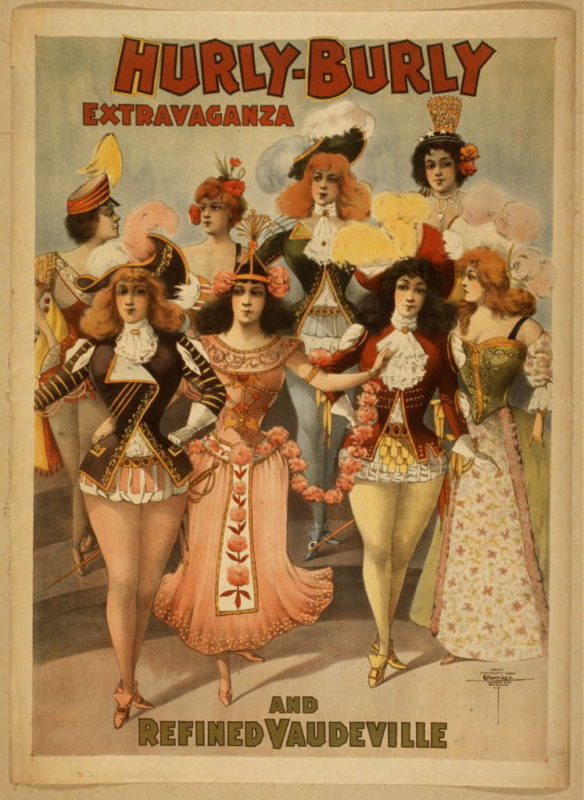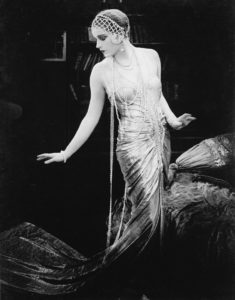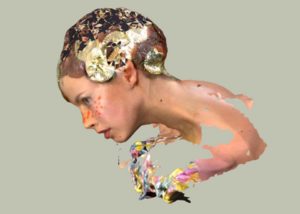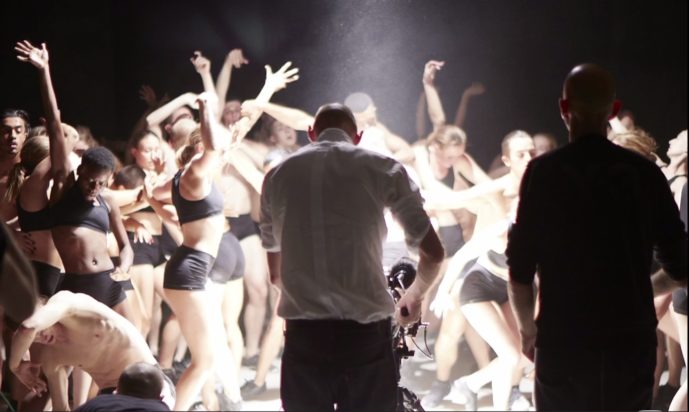Click here to print
Film Dresses Fashion, Fashion Drapes Film
posted February 2, 2018
By Peter Monaghan
When Marketa Uhlirova and some colleagues first organized a festival of fashion in film, in 2006, theirs was a little-studied area of inquiry. So, they threw their net wide, to a range of questions and issues: to pretty much anything relating to fashion and costume and their role in the history and theory of film.
And, conversely, film’s role in fashion.
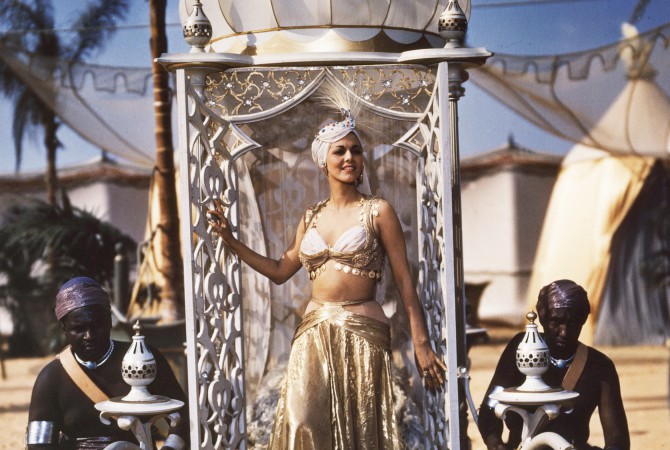
In John Rawlins’s remake, “Arabian Nights” (1942), Maria Montez, the “Queen of Technicolor,” plays Scheherazade, a circus dancer who parades in flamboyant costumes designed by Vera West. The film took Oscars for Best Color Art Direction and Best Color Cinematography, and Lola Montez became, for the likes of 1960s queer avant-gardists like Harry Smith (see below), an icon of screen fashion and identity performance.
Their film presentations and associated discussions bore on the roles of costume in film, film in the fashion industry, fashion as a feature of film, and much else.
The scope was a little crazy, Uhlirova recalls from her office at Central Saint Martins, University of the Arts London. “How does film represent fashion? Where do you even start, with that?” she exclaims.
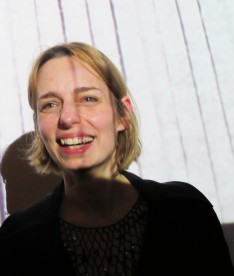
Marketa Uhlirova
The subject is “kind of endless because costume is in most films.”
Nonetheless, she and her colleagues have set about exploring that and related questions, in a series of festival/conferences held every year or two, since that first event. The gatherings bring together film makers, theorists, archivists, curators, and historians, as well as fashion designers and others. Uhlirova, who is director of Fashion in Film, a research and exhibitions project based at Central Saint Martins, has placed the events at well-known museums and film institutes in a roster of cities that echoes an international fashion calendar: London, Miami, New York, Copenhagen, Prague… The most recent event has just taken place [24-26 January 2018] in Venice.
At the gatherings, Uhlirova and her colleagues ask such questions as: How do filmmakers use fashion and costume to tell stories and convey meaning? More generally, how do they deploy and make use of connections among fashion, costume, and film? And what does film reveal about the history and nature of fashion?
Theirs can be intensely archival work, because they seek to take into account not just popular and mainstream feature films, but also documentary and short films, commercials, newsreels, early cinema, and experimental film. In other words, as Uhlirova puts it, she and her colleagues focus on fashion and film costume to explore the worlds of cinephilia, popular culture, design, art, and the underground.
Fashion in Film History
Fashion and costume have played sometimes surprising roles in the history of film, some relating to film’s own surprising progress.
When moving-image film first came into being, what to do with it was an open question: even basic issues were in play, such as whether it would be primarily a dramatic medium akin to theater or a pictorial medium akin to painting.
The era of stage spectacles was still thriving: vaudeville, which would provide many of film’s first participants, featured a hodge-podge of formats where entertainment was conveyed sometimes verbally — in singing acts and comedy skits, for example — but also through spectacle – tumbling, juggling, animal acts…
It was only natural that some of the effects of the vaudeville stage, and the dramatic stage, would vie for a place in film, too – costume, among them. The stage had magic; trick films — moving trompe l’oeils — were among early film genres. Vaudeville was a moving feast of costume and color — in those regards, it had something that the earliest, generally black-and-white moving pictures did not, although of course movies were so stunning in their novelty that audiences often didn’t notice what they did not have.
In early film, fashion and costume could have quite different roles from those they generally play in feature films today. For example, in the silent-film era, Uhlirova notes, actresses bought or even sewed their own clothes for on-screen roles; or, they went to designers who created for them dresses that brought attention to the designer as much as to the actress. Today’s equivalent, as a showcase for actorly fashion, is the red carpet, but stars of early cinema didn’t especially need red carpets because, as Uhlirova puts it, “the films were their red carpet.”
Some early feature films harked to a theater genre known as the fashion play, to which women came expecting to see the latest in, say, Parisian styles. “That was the unspoken purpose or idea of these plays,” says Uhlirova, “and in many ways cinema took this format on, and developed it in different ways, both fiction and non fiction.”
Since then, cinema has sometimes featured clothing as fashion, rather than strictly as costume – in, for example, product placement, or shopping scenes in which characters visit stores that feature particular designers who are named in advertising and other promotions around the film, or not.
Fashion Film in the Internet age
In one sense, Uhlirova notes, fashion designers were slow to seize the opportunities that cinema provided. For example, as an entertainment for the masses, it delayed until around 1910 the opportunity to put film to full use by encouraging the hand-coloring of, for example, Pathé newsreels and shorts that might highlight fashions, or make imaginative use of costume.
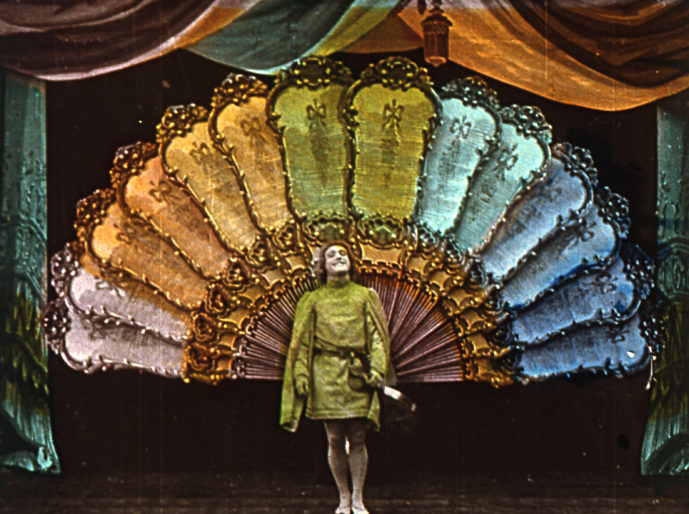
Segundo de Chomon’s “Le Troubadour” (Pathe, 1906) was shown at the 2010 Fashion in Film Festival, held in London, as a particularly outstanding example of hand-colorisation of film to enhance the use of costuming to advance a film’s themes.
In an historical echo, the fashion industry was similarly slow, 15 to 20 years ago, to make much use of the Internet. For design houses, online opportunities to publicize their products are now too great to ignore, but that was not the case until about 2006. One of the first channels to present and produce fashion-related videos, SHOWstudio, began operations in 2000; at that time, Internet users were beginning to be able to watch moving images on their home computers. However, says Uhlirova, “it was buffering for ages, and that was not exactly a pleasant experience.
“It was a beginning, but it took a good six to eight years before companies started to produce fashion films that were meant for the Internet.” In the interim, when large clothing companies made films about their lines, they contented themselves with making them as cinema advertising.
YouTube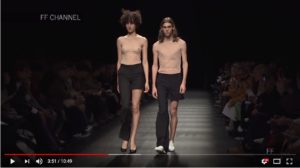 arrived on the scene in 2005, and then was purchased by Google at the end of 2006, and that gave rise to the behemoth fashion channels of today, such as the Fashion Channel and FF [Femme Fatale] Fashion.
arrived on the scene in 2005, and then was purchased by Google at the end of 2006, and that gave rise to the behemoth fashion channels of today, such as the Fashion Channel and FF [Femme Fatale] Fashion.
Those provide an endless parade of catwalk shows featuring designs of quite varied plausibility. As repetitive as the catwalk videos may be, the efficient functionality of the catwalk show was proven long before filming and Internet-streaming them became de rigueur.
One-upmanship has been as much a temptation in fashion netcasting as in many other walks of life: many fashion houses are acceding to such “concepts” as kickstarting their catwalk shows with dancers or boosters of other varieties. The results risk hammy theatricality, or worse.
Whether you find some of the most ambitious catwalk films over the top may depend on what you thought of Busby Berkeley. At their most showy, catwalk videos seem to aspire to his glorious excess, albeit with more-falutin’ high-concept pretensions. Item: the Chanel Pre-Fall 2017/2018 (Paris/Hamburg) Fashion Show (which also exemplifies the subgenre of the catwalk show that is so ambitious it even gets its own video about the video.) (Chanel, with head designer Karl Lagerfeld, has just released a video of its spring-summer 2018 haute couture collection, less ambitious but just as scenically situated.)
Fashion, because often eminently lampoonable, can be a gift to the great cineasts. In a transcendent scene in his 1972 film, Roma, Federico Fellini created an hilarious but haunting ecclesiastical fashion show.
The advent of bufferless Internet streaming permitted the presentation of fashion-related film far more varied than today’s endless catwalk shows. The SHOWstudio channel has commissioned numerous short films that reflect on fashion, somewhat as the recently enlivened genre of the video essay reflects on the nature and content of film. Imagine, for comparison, the idea of music reviews in the form of musical compositions about other musical compositions, or that reflected on aspects of music.
Experimental form versus commercial vehicle
Uhlirova describes fashion films on SHOWstudio and other platforms as examples of “very much an experimental form that was devised as a form of thinking for image makers, about clothing.”
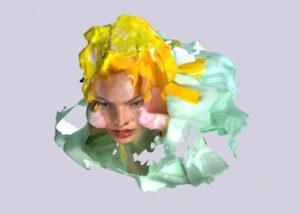 So, for example, one early posting on SHOWstudio, which bills itself as “The Home of Fashion Film and Live Fashion Broadcasting,” was Nick Knight and Jane How’s Sweet, which experimented with three-dimensional imagery as a medium for exploring ideas about fashion. In it, stylist Jane How recreated recent fashion “looks” using cupcake wrappers, candy packaging, and doilies, which fashion filmmaker Nick Knight captured with a 3-D scanner.
So, for example, one early posting on SHOWstudio, which bills itself as “The Home of Fashion Film and Live Fashion Broadcasting,” was Nick Knight and Jane How’s Sweet, which experimented with three-dimensional imagery as a medium for exploring ideas about fashion. In it, stylist Jane How recreated recent fashion “looks” using cupcake wrappers, candy packaging, and doilies, which fashion filmmaker Nick Knight captured with a 3-D scanner.
Knight has used film to assist one fashion designer, Gareth Pugh, based in London and known for his grand clubware, to move away from catwalk shows to a strikingly different form of display: Knight creates fashion films for Pugh that have shown at, for example, the British Film Institute’s IMAX theater. In a recent work created to showcase a Pugh collection, Knight and his collaborators used clay and paint to transfigure human forms into grotesques, which he juxtaposed with the roiling bodies of dancers. His approach, Knight wrote in accompanying notes, “expresses the intensities of Pugh’s collection” and “interacts with Pugh on both a physical and cerebral plane, pushing the boundaries of fashion imagery.”
In a video interview on SHOWstudio’s site alongside the film, Knight explained his approach: “I get away from all that film way of working. Films are great, and they do their thing, but fashion films are a completely different medium; it’s a completely new medium and in my belief it has to come from the language of fashion photography.”
In another, short film on the SHOWstudio site, film editor Lou Stoppard and filmmaker Ruth Hogben take inspiration from some recent fashion designers’ fascination with such themes as vulgarity, cheapness, garishness, and “deliberate awkwardness” to reflect on how definitions of beauty change over time.

Nick Knight and his first assistant Britt Lloyd. SHOWstudio.
To foster filmmaking that explores “the possibilities of showing clothing in movement,” Knight hosts a showcase of aspiring fashion filmmakers’ short works.
(If you fancy watching how Knight works, he has posted a video record in five parts totaling some 36 hours of a cover shoot for 10 Magazine featuring 12 models with known links to the annual Victoria’s Secret Fashion Show.)
Other sites for viewing fashion films include Nowness, a design site that has a fashion-film section and a fashion-and-beauty section (this one is amusing); Fashiontv, which has compilations of its selections; Vimeo Fashion Films Channel, including this insight to how designs arise; and Test magazine (posts seem to date from 2012 and before).
Various fashion film festivals operate, in the fashion-film space, including Milan Fashion Film Festival; Berlin Fashion Film Festival; Mercedes-Benz Bokeh Fashion Film Festival, in South Africa; Australian International Fashion Film Festival; and La Jolla International Film Festival.
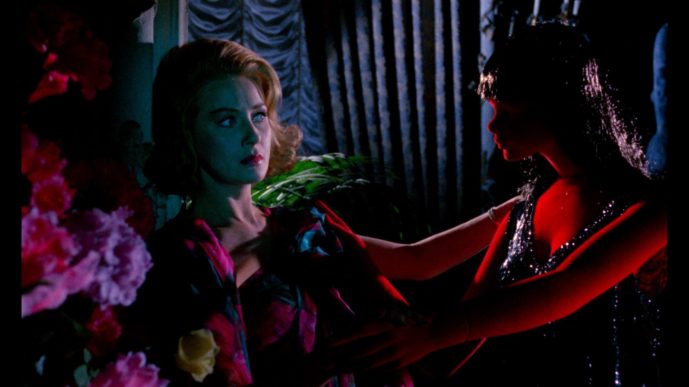
Mario Bava’s “Blood and Black Lace” (1964). At the second Fashion in Film Festival in 2008, in London, film historian Tom Gunning used the film to illustrate the role of fashion and costumes in cloaking ne’er-do-wells in invisibility and disguise in detective films and literature.
Says Uhlirova: “There’s a real sense of renaissance of the genre of fashion film, the sort of nonnarrative, nonfiction film which showcases fashion on the Internet. There has been a real growth in that field over 15 years, especially as the fashion industry has embraced fashion film as a viable form of promotion.”
She has one reservation about that growth: “It’s become very, very mainstream,” she says. “My own feeling is that fashion film in the last few years has become quite institutionalzed in the industry; it’s quite quickly become a commercial vehicle for brands to promote their clothing, whereas in the very early days, with SHOWstudio and other platforms, it was very much an experimental form.”
Less prominent, now, than seemed likely, a decade ago, are examples of films that raise questions about the nature of fashion. “Too quickly,” she suggests, “fashion film became equated with advertising film, and of course that’s just one aspect of it.”
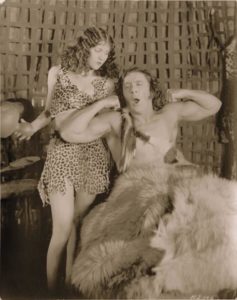
A restoration of “Fig Leaves,” by Howard Hawks, 1926, was shown at the 2007 Fashion in Film Festival, at the Museum of Modern Art in New York, and discussed as a satire of fashion’s subversion of morality. The film is thought to have influenced the latest animated cartoon series, “The Flintstones.”
Uhlirova and her colleagues’ recurring Fashion in Film Festival defines itself against that drift into commercialism. It adopts cultural and historical analytic stances. It has, for example, concentrated on what Uhlirova describes as “films that specifically speak about fashion, that represent the fashion industry as an environment, as a kind of practice.
“That could be a modelling agency, so we showed Frederick Wiseman’s Model, or it could be fashion shoots, so we looked at William Klein’s Who Are You, Polly Maggoo?, or it could be the fashion salons, so we looked at Fig Leaves, by Howard Hawks.”
Fig Leaves (1926) is a battle-of-the-sexes comedy set in part in a prehistoric past that “surely influenced The Flintstones,” as the second Fashion in Film Festival’s program notes observed. Who Are You, Polly Maggoo? (1966) spoofs the fashion world; Polly is a model hounded by lecherous men. Model (1981) depicts “the excitement and the emptiness” (New York Times) of a high-powered New York modeling agency in quest of “the look.”
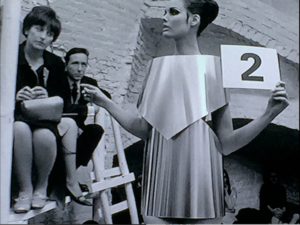
It has been in poring through archives that some of the most interesting connections among eras and kinds of film and fashion have emerged, Uhlirova says. That is reflected in the festival’s programming. In the just-completed event in Venice, for example, one session on “radical fashion in motion” focused on the role film played in promoting anti-consumerist ideals in 1970s Italian design, particularly Nanni Strada’s geometric, compressible, futuristically stitched clothes and tight, seamless, tubular garments.
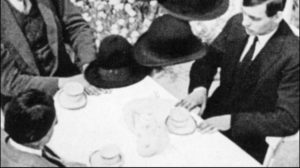
Above: William Klein’s “Who Are You, Polly Maggoo?” (1966); below: Hans Richter’s Dadaist film, “Ghosts Before Breakfast” (Vormittagsspuk, 1927)
Another session explored one of Uhlirova’s particular, archive-driven fascinations: the resonances among three historical periods of fashion and film in Europe and the United States: the earliest films, popular exotic spectaculars of the 1910s and 1920s, and underground cinema of the 1960s (often “queer” film: see Jack Smith’s groundbreaking and inflammatory Flaming Creatures), in each of which “dress was foregrounded as the star of the show,” she says.
So, one session of the Venice festival featured fashion newsreels, commercials, fashion films, video lookbooks, and trick films from throughout the history of film to show some ways that filmmakers and fashion designers have collaborated using new moving-image technologies.
Another session, titled “The Enigma of Clothes,” used archival shorts from British Pathé and The Library of Congress as well as early filmmakers and artists such as Georges Méliès, Hans Richter, and Man Ray, and 1960s/70s avant-gardists like Kenneth Anger and Christine Noll Brinckmann who have made films that, rather than rely on conventional storytelling, have animated clothing – made them fly, spin, folk, touch… in playful, dreamlike ways. In, for example, Hans Richter’s Dadaist film, Ghosts Before Breakfast (Vormittagsspuk; available online from the Internet Archive), from 1927, a bow tie travels around a man’s neck, undoes itself, and slips away; hats fly off gentlemen’s heads; and beards appear and disappear. Kenneth Anger, in his Puce Moment (1949/66), deploys a parade of vintage gowns as near-abstract images to evoke “the archetypal moment of a film star dressing up.”
Themes like those — of fashion as display and performance of identity — have echoed through the Fashion in Film festivals. The third of them, in 2010, was titled Birds of Paradise. Says Uhlirova: “The question there was: Is costume a form of cinematic spectacle, and how can we reframe costume from the idea that it serves to build a character to the idea that it’s a spectacle in its own right?”
Other festival themes have included why film so often ironizes fashion at the same time as it embraces it; how clothing and costume has been used to stylize cinematic crime and violence; and how clothing and costume have been used to mark and configure time, in cinema.
Taking stock of new critical approaches
Uhlirova and her colleagues in mounting those festivals — among them, Caroline Evans, a professor of fashion history and theory at Central Staint Martins, and University of Chicago film historian Tom Gunning — have collectively paved the way for new approaches to the intersections of fashion and film. In Uhlirova’s latest project, The Archaeology of Fashion Film, she, Evans, and other collaborators, are looking more intently at those two transitional periods of film, fashion, and technological transition: early film, and the advent of digitized audiovisual works.
“We’re looking at these two periods, and the aesthetics of the films, but also at the cultural conditions that shaped the films in both these periods,” says Uhlirova.
“We are really emphasizing the archives as an important part of the project,” she explains. “So many films that could have a bearing on understanding of film and fashion “are stuck in archives, and not many people have seen them.”
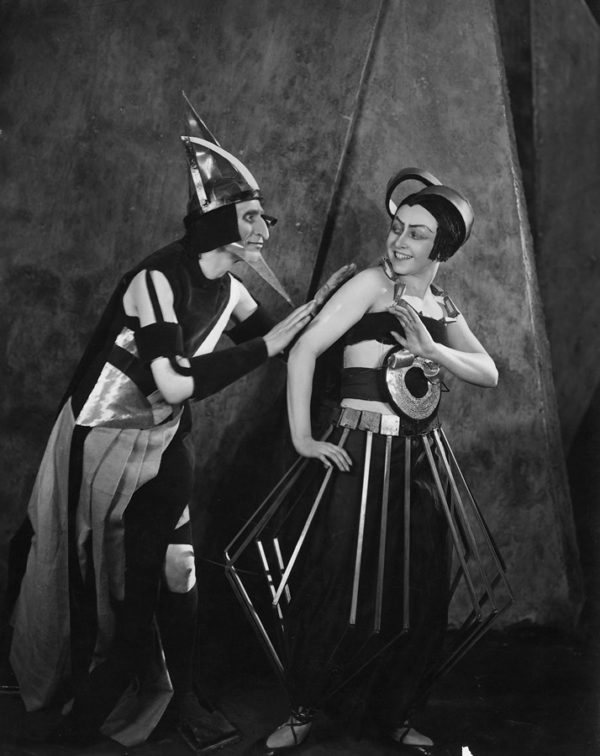
In early Soviet director Yakov Protazanov’s 1924 silent film “Aelita: Queen of Mars,” starring Valentina Kuindzhi (above right), the action shifts from daily life in post-war Soviet Union to a science-fiction world on Mars where a popular uprising assisted by Queen Aelita, who has fallen in love with the hero, Los, challenges the ruling Elders.
Fashion designers may in most cases be too busy to undertake the range of research she and her colleagues have embarked on — at major archives in Paris, Amsterdam, Washington DC, and elsewhere, but also lesser-known ones, such as private and public collections in and around Paris and elsewhere — but “designers are always desperate for rare, obscure, esoteric material that perhaps nobody has seen, certainly that is not online, so they can have something tangible to develop designs and their design thinking around,” she says.
That bodes well for festivals like hers, she says: “Designers really appreciate the physical, material thing that they can hold or they can look at. Equally they appreciate and understand the value of being shown a 35mm film in an archival setting, on the big screen, where they can properly digest and absorb the materials.”
It is in “meditative moments” of archival searches and viewing, she says — “this thrill of discovering something new but not just for the sake of having something new to show but also for the sake of understanding better what I’m looking at” — that the gratifications of film and fashion are at their greatest for her: “I’m an archival junkie.”
Printed from Moving Image Archive News: https://www.movingimagearchivenews.org
URL to article: https://www.movingimagearchivenews.org/film-dresses-fashion-fashion-drapes-film/
Click here to print
